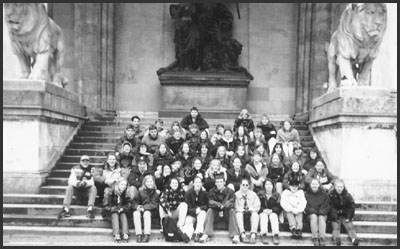
The Paynesville High School students, who went to Germany this spring,
posed for a picture on Easter Sunday in Munich.

The Paynesville High School students, who went to Germany this spring,
posed for a picture on Easter Sunday in Munich.
On April 2, 59 students from the Paynesville Area High School German classes returned from a two-week immersion in the German culture. The Paynesville students met up with 22 more from Minnewaska High School and together flew to Germany to experience firsthand many history filled cities, including Marienberg, a medieval fortress built in 1253 AD; the city of Ulm where they saw the Ulm Cathedral with the world's tallest spire, and climbed the 768 steps to the top; Munchen, where the students experienced Bavarian cuisine at the Pschorr-Keller; and the astounding city of Rothenburg, a city frozen in time, structurally unchanged since the 1500s.
Travel from Minneapolis to Frankfurt, Germany, as well as between the various cities and villages went smoothly. Students had several opportunities to venture out into the cities without the group, but were required to go with a friend when sightseeing. This policy was followed, except when Jennifer Nelson was accidentally left behind at the depot while talking to a friend she had met there, and ended up walking the four blocks back to the hotel.
The first city the students experienced was Wurzburg, one of the many historical cities of Germany. They visited the fortress Marienberg, an originally fortified retreat of the Hallstatt period around 1000 BC. The foundations of the castle were built in 1253 AD; the stone walls still surround it. Several students were most impressed with the original hand dug well; so deep they couldn't see the bottom.
Wurzburg was the student's first opportunity to explore on their own. "We ordered our first meal in German," said Erin Pelton. Even though the students were able to speak the language, many Germans recognized them to be Americans and spoke English to them. "Everybody knew English, and knew I was American," commented Sarah Lahr.
On the third day, the students arrived in Ulm, the city in which Albert Einstein was born, where each student stayed with a German family, there, and in the surrounding villages. They lived with their families for five days.
Students were excited and nervous at the same time; not knowing exactly what to expect. Jenny Wendland's family spoke no English, even so, she said, "My family stay was the best." Rissa Elliot agreed the five days she spent with her German family was the high point of the trip. Even with some language and cultural barriers, after five days together, the students and their families grew quite fond of each other.
Several students went to school with their German siblings and saw some differences between the German school system and an American one. German schools work on a system similar to American universities. Students who do well academically go into a university preparatory program, called gymnasium. This is decided usually by the sixth grade. Other students finish their education in Realschule, where they learn more practical skills, and often by the age of 16 to 17 the student is finished with school and goes into a particular line of work.
German students have four to five classes a day and are done by 1 p.m., but their summer vacations are shorter, lasting six weeks.
While with their families many students also went on outings. Kim Colbert and Sarah Lahr went to Mainau, an island off the coast of Germany, and numerous students saw the castle that was the inspiration for the replica at Walt Disney Land. Erin Pelton's family took her to a cave with stalagtites.
At the end of their stay in Ulm, the group climbed the 768 steps which spiraled to the top of the highest church tower in the world.
After taking in the sites at Salzburg, Austria, the students spent two days in Munchen. They enjoyed traditional Bavarian Cuisine at the Pschorr Keller. This traditional Bavarian restaraunt was founded by King Max I in 1815 as a beerhall. The Pschorr brewery purchased it in 1865. Although destroyed in 1944, it was reconstructed in 1948, and now presents a typical Bavarian atmosphere.
The medieval city of Rothenburg was the high point for several students. The town, which is prohibited from architectural modernization, looks exactly as it did in the 16th century. The old wall still circles the entire town. Even the shops aren't allowed to expand; merchants must make their businesses fit the space. Students were amused, though, to find one of the small shops was a McDonalds.
While in Germany the students also visited Herrnchiemsce Castle, which King Ludwig built on an island as a replica of the Palace Versaille in France. The castle was equipped with many conveniences unheard of at that time, including a heated pool. The ceilings hung with 56 chandeliers, each one worth more than $1 million in crystal by today's standard.
The group attended an Easter mass while in Munich, as well as saw where Hitler gave many speeches; and walked through Dacau, the oldest concentration camp in Germany, where 37,000 people were killed.
"It was a great experience to get a taste of Germany in ways you just can't learn in class," Kim Colbert said.
Along with the Weinerschnizle, Spatzle, dumplings with vanilla sauce, and Wurzes, their time in Germany will be an experience these students will remember their lives through.